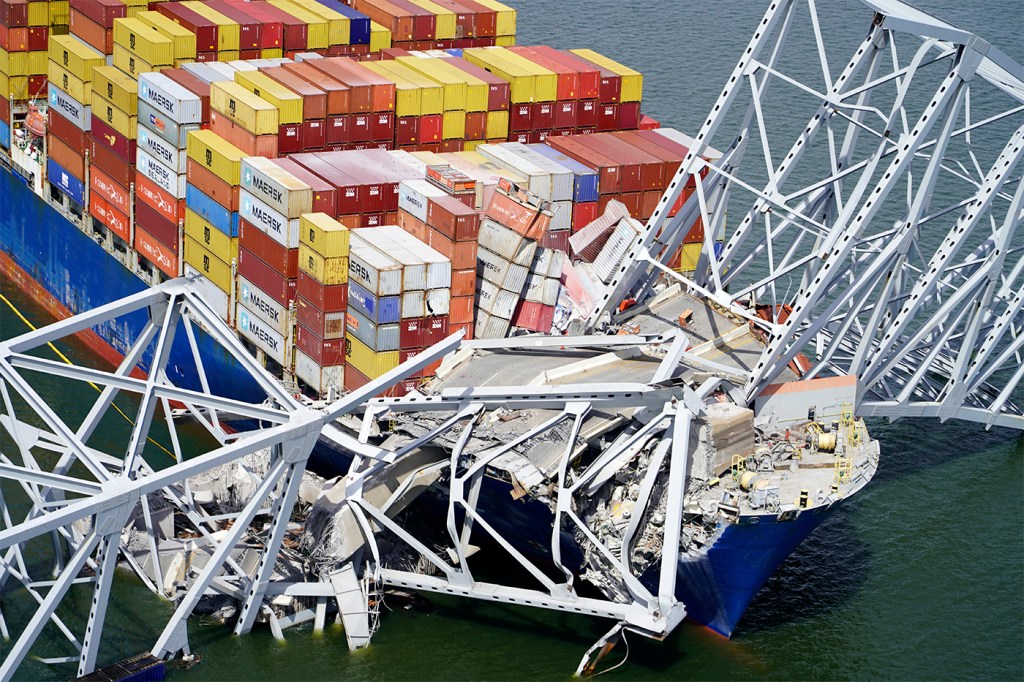A focus on resilience could have saved the Baltimore bridge, says Northeastern infrastructure security expert
What began as a local disaster quickly cascaded into a catastrophe with consequences for the global economy. A Northeastern expert says conventional thinking about infrastructure security is to blame.

When a major Baltimore bridge collapsed this week after a container ship struck a support column, access to the Port of Baltimore — the nation’s primary port for automobiles — was shut off indefinitely.
What began as a local disaster quickly cascaded into a catastrophe with consequences for the global economy. The Francis Scott Key Bridge, which was the second-longest continuous truss bridge in the U.S., now sits partially submerged in the Patapsco River. Officials are now working to clear the debris and reopen the port in what could be a monthslong process.
While hardly the same in terms of the scope of impact, Tuesday’s disaster is reminiscent of the collapse of the Sunshine Skyway bridge in Tampa in 1980, which resulted in new protections (mini-island barriers) that shored up a replacement bridge built some years later.
Stephen Flynn, professor of political science and founding director of the Global Resilience Institute at Northeastern, says that while the Sunshine Skyway bridge calamity served as a teachable moment, its lessons weren’t carried over to other parts of the system. The Francis Scott Key Bridge had no fender system in place to mitigate a collision.
Flynn, also a retired Coast Guard officer, says that a focus on resilience — a concept he champions — could have prevented the disaster in Baltimore, and could act as a mainspring in the prevention of future disasters. He argues that the conventional thinking about infrastructure risks doesn’t adequately identify vulnerable structures, let alone protect them.
Northeastern Global News spoke to Flynn about Tuesday’s disaster. The conversation has been edited for brevity and clarity.

What is your assessment of this disaster?
One of the biggest challenges is that we’re bringing massive new ships into old ports, and the infrastructure that makes that port and the surrounding community operate has not kept pace with a global maritime industry that operates on the principle that “bigger is better.”
The largest container ships transiting the Chesapeake Bay in the mid-1980s when I was patrolling those waters in command of a Coast Guard Cutter were about one-quarter of the size of the MV Dali, and Dali is about a third of the size of some of the newest container ships. That kind of gives you a scale of what’s been happening over the past 30 years. What’s driving this? Essentially, we get economies of scale and greater efficiencies by going bigger and bigger — and bigger is viewed as better, from a market standpoint. And yet our shoreside and port infrastructure had to keep pace with that, to keep up with the associated new risks. We obviously haven’t been thinking all of this through. That’s the context in which this disaster has played out.
What is your approach to mitigating the risks posed to key parts of our infrastructure?
The last comparable major incident of a ship striking a bridge was the 1980 incident that happened in Tampa Bay with the Sunshine Skyway Bridge. I went back and took a look at that bridge, and the new span that they built had this island around the support column meant to protect the bridge from another collision. That was a clear recognition of the ship collision risk back then; and yet the question that wasn’t asked was: what other bridges are there that span important shipping channels, where the columns sit in the waterway and should have some kind of barrier around them so what happened in Tampa won’t happen in there? That assessment never happened, and in part it didn’t happen because the way we think about risk is probabilistic-based. The Tampa bridge disaster was assumed to be a freak event.
I’ve been arguing that we need to move from assessing risk based primarily on assumptions about the probability of a threat- or hazard to one that emphasizes a resilience-centric approach. What we have to do is step back and first ask the question: what is really valuable? What is really essential to our modern way of life? It’s not everything. Some things are really, really important; like a bridge that could close a shipping channel that shuts down the fourth largest port on the Eastern Seaboard. That’s a really important piece of infrastructure. And it’s important to emphasize that we’re talking about one particular bridge — not all bridges; not the one upstream that goes to Curtis Bay, for example. That one is not nearly as consequential.
A resilience approach would ask where are there bridges in key navigable channels that if they failed, it would cause havoc. Then you assess if they have vulnerabilities that could lead to their collapse. If there are, you should put safeguards in place; you would think through the safeguards — regardless of whether you could assign a high probability to any given scenario since the consequence of the asset of system failing would be so high. I would also note, there are always unknown risks. That’s the other key part of what I call the resilience imperative; that it’s animated not so much by the prevalence of hazards or threats — there have always been hazards or threats — but by the fact that increasingly we rely on systems that are interconnected, and in some cases, hyperconnected. Hazards that used to have more localized consequences now cause cascading failures that are more far-reaching and difficult to predict.
A resilience approach also involves thinking carefully about infrastructure design. A resilient design is not one whose aim is to fully protect something at all costs. Instead it focuses on being able to bend, but not break. For a bridge, we should not devote all our effort on building a support column that could stand up against any ship that could hit it — that is a bit daunting. What we need to think about instead is how do we redirect the hazard in a way that will cause less harm? We can do this by designing a barrier around the column that would cause a ship that comes in contact with it to veer away.
Where do we go from here? Do you see any policy changes on the horizon to better protect our infrastructure?
I do think this disaster is going to command more of our attention than other accidents such a major airline crash because it is going to take so long to get things back together again. We’re just barely sensing the pain and the disruptions coming from this tragic accident, and that will only compound over time. It’s likely that they can probably clear the debris out of the main channel, or enough to get the ships going again, in several weeks. But we’re looking at probably a minimum of 60 days because you have hazardous materials that have to dealt with. You’ve have major pieces of the bridge on top of the ship, which you have to figure out how to remove. It’s like a jigsaw puzzle where you have to survey all the debris. Then you need to figure out how you cut up the debris in a way that’s safe enough that you can remove it without hurting the people involved in the salvage operations to include those who are working underwater in the murky Patapsco River. It’s really a complicated problem to solve, and a lot of capability will be needed.
As time goes on, we’ll start to better understand the many cascading consequences that comes with blocking a major port. One of my axioms is that when it comes to teach about resilience, a disaster is a terrible thing to waste. In other words, this is a teachable moment. Disasters command our attention, but too often it’s a waning attention. In this instance, how quickly the media has been providing information about the impacts on the supply chain has the potential to be very helpful towards informing the kinds of public policy actions that need to be take. I think there’s now good material here — and awareness.
Going forward with respect to safeguarding major bridges, the Coast Guard, my old agency, is responsible for overseeing bridges over navigable channels. They should be directed to lead a comprehensive risk assessment of the bridges that span the nation’s major waterways and lead the effort, along with the U.S. Army Corps of Engineers to come up with a menu of safeguards to mitigate the risk associated with the new generation of large ships.
One thing I’ve been impressed with in the aftermath of this disaster has been the effective incident command structure that has been rapidly assembled, where you’ve got everyone who should be involved talking to each other. The standard disaster protocol is to first focus on saving lives, or the rescue operations. Then the focus usually turns to conducting the investigation prior to beginning recovery. In this instance, there has been a recognition that the investigation is going to be very complicated and that it is urgent to reopen the port. So the approach is to have the investigation proceed in parallel with efforts to recover which is a positive thing from a resilience perspective.
